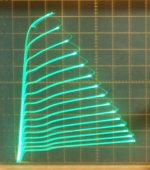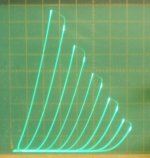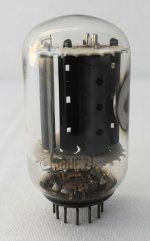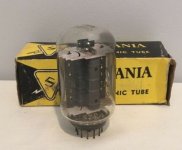s on the dollar list until it got mentioned here, then poof all of them were gone, off to Asia.
Which is exactly the reason why I never mention the exact numbers of certain interesting valves any more.
In fact some of the later EU & US 60s-70s ones are already drying up and disappearing to PRC etc.
I suspect the better Russian ones are already going this way too.
Having watched with interest I note there are several operators on EBAY, eg. Taiwan, Hong Kong, India, that clearly exist to specialise in buying up stocks of valves the moment they get a hint, then speculate on it all, so they could make a lot of money.
It's simple capitalistic greed at work, no need even to have brains.
I see a lot of those very items turn up about 2-3 yrs later at something like 20-50x the original cost, sometimes even 100s of times higher.
I am convinced they watch pages like this, then make their stab at a given value, and then drive the prices thru the roof.
As a result of that, to ensure supply, I did myself buy up pretty much the entire world stock of one interesting valve,- not to make money with, but to make it possible to make matched quads of them in order to make a complete product.
I can see some of the later British 807 manifestations going this way quite soon.
This is why it's a good idea to find a tube type you like, look at equivalent versions that are less popular(different heater voltage, pinout, etc) and buy them while they are still affordable. The great thing about DIY is that you can keep things like this in mind to future-proof your builds, with sweep tubes especially there are so many of the same tube in different clothes that it's nice to build it with 12 or 25 volt filaments that can easily be rewired for 6 volt later on. I've been buying my favorite tubes in several flavors off and on as I find them, and I now have enough of each to build with and retube projects for a very long time.
Do not ignore the more unusual/affordable Russian tubes, find some designs that use them well, and buy a case for yourself while you still can. Plenty of fine tubes are still available for just a few bucks each that will drop right in to various quality amplifier projects with little to no specific consideration needed.
Do not ignore the more unusual/affordable Russian tubes, find some designs that use them well, and buy a case for yourself while you still can. Plenty of fine tubes are still available for just a few bucks each that will drop right in to various quality amplifier projects with little to no specific consideration needed.
I like the xCT3 on the 1USD list.
Stupidly cheap PSU diode with mega current handling.
I always wanted to use a 230V CT toroid secondary with another idea, (Triad VPT230-1090), -just connect the 4 heaters of 2 pairs of *HE7s (5-7USD) a la TV, across the secondary in series. (212V)
That way you get a high power stable 300VDC, and derive a -25V bias from across the last in the line *CT3 rect heater.
That valve has double the gain of 6V6, and can dump a peak cathode current of 800m/a.
A plate resistance of 6200ohms, what's not to like?
Tiny too!
Stupidly cheap PSU diode with mega current handling.
I always wanted to use a 230V CT toroid secondary with another idea, (Triad VPT230-1090), -just connect the 4 heaters of 2 pairs of *HE7s (5-7USD) a la TV, across the secondary in series. (212V)
That way you get a high power stable 300VDC, and derive a -25V bias from across the last in the line *CT3 rect heater.
That valve has double the gain of 6V6, and can dump a peak cathode current of 800m/a.
A plate resistance of 6200ohms, what's not to like?
Tiny too!
The low Pd and the 12 pin base? 😛 Still, judging by the 6.3V@2.7A of heater, this tube can handle way more than peaks of 800mA, probably closer to twice that. If I find some (my friend has a bunch of 12 TV tubes), maybe I'll try them out in triode.
The low Pd and the 12 pin base?
Low Pa limit means very little.
A valve does not dissipate the most at highest or lowest anode voltage,- but following the load line,- hence, a pair of 25W Pa valve can produce an output of more than double that as audio. (807 - 80-120W AB2), or a 19W valve pair makes even in Ab1 a good solid 50W.
This particular valve has a 19W anode, only derated because of the diode next to it, which dissipates hardly anything at all at the moment the beam power part dissipates its max & vice versa.
If you compare this with the case of the 6V6 (also available in small format, - 12 pin or noval), it's an unfair contest.
The *HE7 can easily knock out a clean 40W, hardly trying, (or 15-18W in class A) while the 6V6 can't get beyond 10W without high distortion in AB1, and much less in class A.
It also has a high gain screen grid, so quite possible to drive in screen drive.🙂
A large proportion of the 38HE7 (but not the 12HE7) allow one to run just the pentode in the bottle using 21V Htr at 0.45 Amp on pins 10 an 12. The pentode is very close to a 21HB5 (18 W rated), but with some plate edge clipped off to fit in the bottle with the damper diode. So without the damper heat dissipation, I would up rate it's datasheet rating from 10W to maybe 15 W using a TV Sweep standard. Which could be higher by an audio standard.
Curve tracing the 38HE7, I found that two in parallel are equivalent to the older version of the 42KN6. Which was 30 Watt rated for the two pentodes inside paralleled. And that draws 0.45 Amps Htr too at 42 V.
The _HE7 has decent triode curves (2nd pic below) so should be nice for audio in either mode. (pic 1 is the pentode curves)
Being on the $1 list still is a nice bonus.
Curve tracing the 38HE7, I found that two in parallel are equivalent to the older version of the 42KN6. Which was 30 Watt rated for the two pentodes inside paralleled. And that draws 0.45 Amps Htr too at 42 V.
The _HE7 has decent triode curves (2nd pic below) so should be nice for audio in either mode. (pic 1 is the pentode curves)
Being on the $1 list still is a nice bonus.
Attachments
Last edited:
without the damper heat dissipation, I would up rate it's datasheet rating from 10W to maybe 15 W using a TV Sweep standard. Which could be higher by an audio standard.
The _HE7 has decent triode curves (2nd pic below) so should be nice for audio in either mode. (pic 1 is the pentode curves)
Being on the $1 list still is a nice bonus.
I would say not to worry about the damper diode.
It was designed for a whopping current .35A to drop only 21V..ie.about 7W.
If used as a rectifier diode a pair of these *he7 at 300V only draws 60m/a for 2 x 9W at idle, while the diode would dissipate not even 1W.
A full wave rectifier or doubler takes 2 diodes so neither working specially hard.
At peak current of 200m/a at 50V anode the pentode will diss 10W, the diode probably only about 3W,
(I have to make some reserve tho, seeing 5W on the screen grid, which could push the total small bulb diss with the 17W heater to well over 35W !)
..so "normally" I can't really ever see the thing running much more than quite hot (200C), in any case no doubt nothing even close to what you might see on a hard driven ECL86 or 6BQ5.
Last edited:
Connect it as a triode, and run a pair at 300V B+ with 80mA current each. From the pictures, it should work for 24W Pd. A 1k3 anode - anode load should make decent power of some 25W - 30W. You'll need some 50V to drive it though.
I have often wondered what, exactly, is the reason that the 6V6 tube sounds so good as a guitar amplifier power device? It is sweeter-sounding than the 6L6, EL34/84 or others to my ears.
But unless you only swapped the tubes around in the same amp, you're not just hearing the difference between tubes, you're also hearing the different components. Who knows if the amp is even the same topology, right? It could be the lower power easier to sag 5Y3 they might use instead of a 5AR4 or something like that, too. Higher Z OPT usually for 6V6 than 6L6 too.
I have often wondered what, exactly, is the reason that the 6V6 tube sounds so good as a guitar amplifier power device? It is sweeter-sounding than the 6L6, EL34/84 or others to my ears.
I built a Marshall 18 watt lite for a buddy a while back initially with EL84, then with 6V6 outputs, no other changes from EL84 other than cathode resistance for proper bias. It made a pretty obvious difference, it sounded much nicer and a good bit cleaner, great for jazz and the intended use with a seven string lead guitar in a church worship band. The fact that the 6V6 in can take more grid swing for a given output likely contributed a lot to the difference, likely something about the front end sounding better with higher signal level. Highly recommended if you're thinking of an 18 build.
The obvious rollover in the 6V6 triode curves make it likely to have high 2nd harmonic distortion. Which would end up as 3rd H in a P-P Amp. Maybe contributing to the "sweet" sound. 6JC5 has similar triode curves, would be interesting to hear how that sounds?
Triode mode curves are a big giveaway as to how close the grid has been placed to the cathode, relative to the grid wire pitch spacing. Both tube types have a relatively coarse grid pitch. One would expect the 6JC5 to have higher gm than the 6V6 due to the bigger heater draw, but it doesn't. Would have to see the guts side by side to see what they did re-design wise. The cathodes look fairly similar size.
Triode mode curves are a big giveaway as to how close the grid has been placed to the cathode, relative to the grid wire pitch spacing. Both tube types have a relatively coarse grid pitch. One would expect the 6JC5 to have higher gm than the 6V6 due to the bigger heater draw, but it doesn't. Would have to see the guts side by side to see what they did re-design wise. The cathodes look fairly similar size.
Last edited:
The 6V6 has less than half the gain of the EL84, and the EL84 is a pentode, which makes a massive change to IMD components, as well as the 6V6 needing vastly more drive.
The EL84 remains more sensitive to screen grid again for the same reasons+g2 emission which the aligned grids of the 6V6 don't have.
This drastically alters the harmonic distortion signatures of the valves.
There are a whole host of reasons why the 6V6 can be made to sound so good.
It remains part of my childhood memories,- as my dad built a 6V6 amp for a record player from bits scrounged from all over the place!
The EL84 remains more sensitive to screen grid again for the same reasons+g2 emission which the aligned grids of the 6V6 don't have.
This drastically alters the harmonic distortion signatures of the valves.
There are a whole host of reasons why the 6V6 can be made to sound so good.
It remains part of my childhood memories,- as my dad built a 6V6 amp for a record player from bits scrounged from all over the place!
I said this nearly 40 years ago, and it's still true....
6BQ5's (EL84's) ROCK, while 6V6's were born to sing the blues....
The 6BQ5 has a higher peak current capability and will push that OPT further into saturation when it's driven by a pedal boards full of pedals all set in KILL!
6BQ5's (EL84's) ROCK, while 6V6's were born to sing the blues....
The 6BQ5 has a higher peak current capability and will push that OPT further into saturation when it's driven by a pedal boards full of pedals all set in KILL!
I said this nearly 40 years ago, and it's still true....
6BQ5's (EL84's) ROCK, while 6V6's were born to sing the blues....
The 6BQ5 has a higher peak current capability
But what about the 6V6 in AB2?
Then it will conduct considerably more current than the EL84, which can't be driven that way. (The g2 will melt).
Did you try that?
I am still trying to work out what the heck sort of sound we are getting out of our 807s in AB2. (I don't know what I am looking for, for guitar people!).
Everyone says it's Jekyll and Hyde, but so unbelievably loud it's scary!
It's totally clean to 75W then goes real dirty beyond that, it's unbelievable, and sounds twice as loud as any modern Marshall or Mesa 100W.
I saw one of those CH60 challenger (807-AB2) amps go for only 100USD this week! That's stupidly cheap.
The EL84 can do AB2, but the grid is pretty fragile, probably owing to the fact it wasn't really designed with that application in mind. The 6V6 is old school but much more rugged, I think it's a good trade-off and worth dealing with the lower gain and gm. Besides, I honestly think they sound better in most instances.
You will find the EL84 can't be driven AB2 at all.
It's not the g1 that is neccessarily the problem it's the non aligned screen-suppressor that will die.
All those Mullard pentodes have the same weakness - EL34, EL84.
The moment you start driving them hard the screen grid glows white hot and they collapse.
This is a problem common to most power pentodes..
The Americans & GEC with their beam tetrodes & aligned screens knew this all along, which is why the 6V6, 6L6 and 807 will stand a constant beating without blowing up.
It's why the interesting thing with beam power valves is driving them AB2 and lowering the A-A loads, or doing the same strapped as triodes (so long as the screen can take the voltage)...
The IMD is an order of magnitude greater than pentodes, especially when driven hard, - which is why that, and the higher 3rd harmonic THD make them sound so totally different from true pentode amps.
Low IMD is one of the J.E. things, and to some extent I have to agree with him.
It's not the g1 that is neccessarily the problem it's the non aligned screen-suppressor that will die.
All those Mullard pentodes have the same weakness - EL34, EL84.
The moment you start driving them hard the screen grid glows white hot and they collapse.
This is a problem common to most power pentodes..
The Americans & GEC with their beam tetrodes & aligned screens knew this all along, which is why the 6V6, 6L6 and 807 will stand a constant beating without blowing up.
It's why the interesting thing with beam power valves is driving them AB2 and lowering the A-A loads, or doing the same strapped as triodes (so long as the screen can take the voltage)...
The IMD is an order of magnitude greater than pentodes, especially when driven hard, - which is why that, and the higher 3rd harmonic THD make them sound so totally different from true pentode amps.
Low IMD is one of the J.E. things, and to some extent I have to agree with him.
I don't get it----how does 2nd HD turn into 3rd via P-P?The obvious rollover in the 6V6 triode curves make it likely to have high 2nd harmonic distortion. Which would end up as 3rd H in a P-P Amp. Maybe contributing to the "sweet" sound.
I thought 'sweet" sound came from even-order harmonics--no?
- Home
- Amplifiers
- Tubes / Valves
- 6V6 Output?




